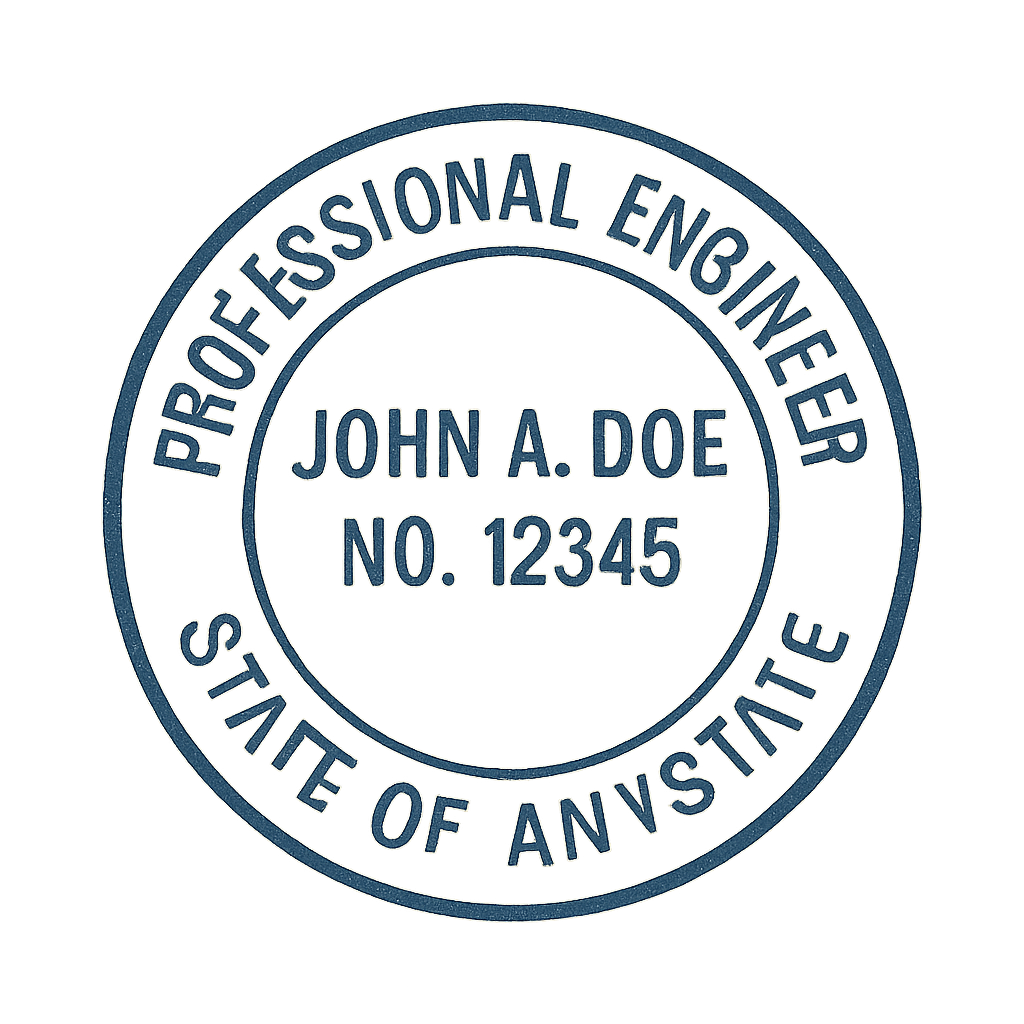Understanding when you need a professional engineer stamp is crucial for many projects. This stamp signifies that a licensed engineer has reviewed and approved the plans.
It ensures safety and compliance with regulations. Without it, projects may face delays or legal issues.
Different states have varying requirements for when a PE stamp is necessary. Knowing these can save time and resources.
This article will guide you through the essentials of professional engineer stamps. Learn from PE experts about when and why you need this important approval.
What Is a Professional Engineer Stamp?
A professional engineer stamp is a symbol of expertise and responsibility. It shows that a licensed engineer has reviewed a project.
This stamp serves as a formal approval. It verifies that the design adheres to applicable engineering standards.
The stamp includes the engineer’s name, license number, and sometimes the state of registration. This identification provides accountability.
Typically, the stamp is applied to engineering drawings and documents. It is crucial in ensuring designs are safe for implementation.
Some key components of a PE stamp include:
- Name of the licensed engineer
- License number
- State of registration
- Date of issuance
A PE stamp can be an inked impression or an embossed seal. The choice often depends on personal preference and jurisdiction.
Understanding a PE stamp’s components helps in recognizing its importance and legitimacy in engineering projects.
Why Is a PE Stamp Important?
A professional engineer stamp adds legitimacy to engineering work. It assures that projects meet professional and legal standards.
The stamp is vital for ensuring the safety and integrity of structures. It helps prevent costly mistakes by confirming designs are sound.
In many jurisdictions, a PE stamp is a legal requirement for certain projects. This stamp acts as a safeguard against engineering failures.
The main reasons for the importance of a PE stamp include:
- Ensures compliance with codes and standards
- Provides accountability for engineered designs
- Represents professional endorsement of a project
Without a PE stamp, stakeholders may question a project’s validity. This can delay approvals and increase liability concerns.
Ultimately, a PE stamp is more than just a mark. It symbolizes trust and excellence in engineering practices.
When Is a PE Stamp Required? Common Scenarios
Identifying when a professional engineer stamp is required can seem complex. Different scenarios demand this crucial validation for legal compliance and safety.
Construction projects often require a PE stamp. For structural integrity, stamped engineering drawings are essential. These include buildings, bridges, and other infrastructures.
Plans for public utilities also need a PE stamp. This includes water systems, sewage, and electrical grids. The stamp confirms the design’s adequacy for public use.
Renovations might need a stamp too. This is especially true when structural changes are involved. Engineer approval becomes crucial for safety in these cases.
Permitting processes frequently require a PE stamp. An engineering stamp for permit applications assures authorities of the project’s compliance with regulations.
Here are scenarios where a PE stamp is commonly needed:
- New building constructions
- Major structural renovations
- Public utility designs
- Environmental impact assessments
In these common situations, a PE stamp affirms that detailed design work meets safety standards. Without it, projects may face approval delays and increased scrutiny.
A professional engineer’s endorsement is more than an administrative formality. It’s a necessary step in maintaining safety and legality in engineering works.
State-by-State PE Stamp Requirements
PE stamp requirements vary widely by state. Each state’s regulations must be reviewed carefully to ensure compliance. Some states have stricter rules, depending on the project type and engineering discipline.
For example, California has specific criteria for a professional engineer stamp. This includes both infrastructure projects and private constructions. Requirements are dictated by the state’s engineering board.
In Texas, a professional engineering license is essential for providing stamped documents. The engineering board mandates specific criteria for approval.
Florida also has its own set of guidelines. These are generally strict, especially for coastal and hurricane-prone areas. The requirements here might be more rigorous than in other states.
Here’s a brief overview of some state-specific requirements:
- California: PE stamp necessary for many structural plans.
- Texas: Stamps needed for all engineering-concerned permits.
- Florida: Essential for hurricane safety compliance.
- Nevada, Arizona, Utah: Varying requirements depending on project scale.
Understanding these differences ensures both compliance and project success. Knowing the local state’s demands can prevent costly legal issues and project delays.
California
In California, a PE stamp is mandatory for many projects. This ensures safety in both public and private sectors.
Engineering disciplines like mechanical, civil, and structural require certified stamps. Regulations here demand adherence to state-level engineering standards.
Texas
Texas mandates a professional engineer stamp for many projects. The state’s focus is primarily on safety and standard compliance.
Engineering drawings and plans must be stamped to obtain permits. The Texas engineering board enforces these rules strictly.
Florida
Florida requires an engineer’s stamp to ensure safety. This is crucial, especially in coastal regions susceptible to severe weather.
Hurricane-prone areas have even stricter requirements. Engineers must follow strict guidelines to receive approval.
Nevada, Arizona, Utah, and Other States
Nevada and Arizona have unique stamp rules based on project size. Engineers must be licensed in those states.
Utah follows similar standards. It generally mirrors neighboring states’ requirements to a large extent.
Types of Engineers and Their Stamps
Different types of engineers require their specific stamps. These stamps indicate the engineer’s expertise and responsibility in a project.
A structural engineer’s stamp, for instance, ensures a building’s integrity in Salt Lake City. This is crucial where seismic considerations are paramount.
Electrical engineers, such as those in Phoenix, need stamps for projects involving electrical systems. Their expertise ensures safe and efficient power distribution.
In civil engineering, like in Las Vegas, the focus is on infrastructure projects. A civil engineer’s stamp signifies compliance with local regulations.
Mechanical engineers in Los Angeles often work on complex machinery. Their stamp guarantees that these designs meet safety standards.
Each discipline uses specific stamps based on its focus and regulations. Here’s a brief list of notable engineer types and their stamps:
- Structural Engineer
- Electrical Engineer
- Civil Engineer
- Mechanical Engineer
Understanding these variations is vital. It ensures that only qualified engineers are involved in critical work.
What Documents Need a PE Stamp?
Professional engineer stamps are essential for many construction and engineering documents. Each document reflects the responsibility and expertise of the engineer.
Stamped engineering drawings are a common requirement. These drawings provide detailed instructions for builders and contractors.
In most states, structural plans with a PE seal are crucial. This ensures the design’s structural integrity.
Stamped construction documents in Florida must bear a PE stamp. This is necessary for legal and safety compliance.
Permits often require an engineering stamp for approval. This shows that an engineer reviewed the plans carefully.
Here’s a list of documents that typically need a PE stamp:
- Engineering drawings
- Structural plans
- Construction documents
- Permit applications
Getting the right stamp ensures your project meets all legal and safety standards. It helps in avoiding costly setbacks.
How to Get a Professional Engineer Stamp
Acquiring a professional engineer stamp involves a structured process. First, you must earn an engineering degree.
Next, gaining relevant work experience is critical. Most states require a minimum of four years under a licensed engineer.
Passing the PE exam is the final step before acquiring the stamp. Once licensed, you can legally stamp documents.
Steps to acquire a PE stamp:
- Obtain an engineering degree.
- Gain required work experience.
- Pass the Professional Engineer exam.
Completing these steps grants you the authority to use a professional engineer stamp. It opens doors to new professional opportunities.
Electronic PE Stamps and Modern Trends
The rise of technology has led to electronic PE stamps becoming more popular. They offer efficiency and security.
Many states now accept digital stamps on engineering documents. This shift simplifies the submission process for engineers.
Benefits of electronic PE stamps include:
- Enhanced document security
- Streamlined approval processes
- Reduced paperwork
Electronic stamps reflect modern engineering practices. They ensure quicker project approvals and documentation handling. This trend is steadily gaining acceptance across various engineering sectors.
Frequently Asked Questions About PE Stamps
People often have questions regarding the professional engineer stamp. We address common queries to help provide clarity.
- What is a PE stamp?
- A PE stamp certifies engineering work, confirming it meets industry standards.
- Who can use a PE stamp?
- Only licensed professional engineers use PE stamps on designs.
- Are there different stamps for various engineers?
- Yes, stamps may vary based on engineering fields like structural or electrical.
- Is a PE stamp mandatory for all projects?
- Not all projects need a PE stamp, but most public works do.
Understanding these aspects helps ensure compliance with regulations. Appropriate application maintains project integrity and safety.
Conclusion: Ensuring Compliance and Safety with a PE Stamp
A professional engineer stamp is more than a formality. It’s a testament to the quality and safety of engineering designs. By adhering to professional engineer stamp requirements, projects gain credibility and meet regulatory standards.
Securing proper stamps from PE certified engineers like those in California or Texas assures project compliance. It’s essential for structural plans and stamped construction documents, ensuring everything adheres to necessary safety guidelines.
As you plan a project, remember to factor in PE stamp considerations. Consulting PE experts helps navigate requirements smoothly. Whether for structural, electrical, or mechanical engineering, a PE stamp plays a crucial role in successful project execution.






